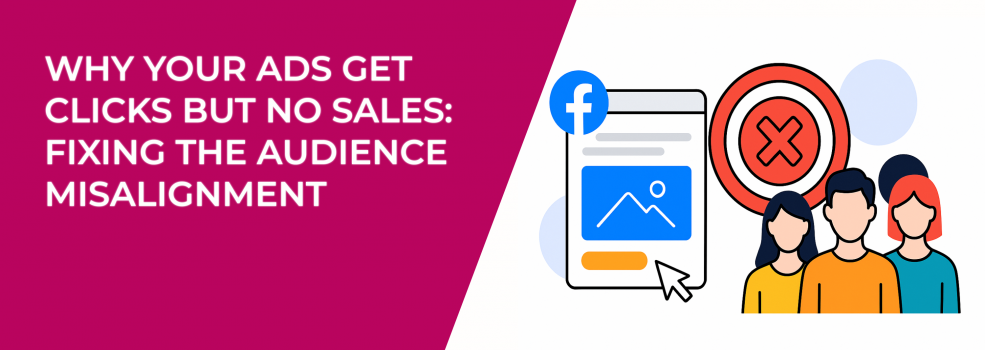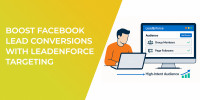Your ad is getting clicks. The creative looks good. The targeting seems logical. But sales? Nothing.
It’s one of the most common and frustrating issues in Facebook and Instagram advertising.
The reason often comes down to this: audience misalignment.
When the wrong people see your ad, engagement can look great, but conversion stalls. Let’s break down why this happens and how to fix it.
Clicks Without Conversions? Here’s Why It Happens
A click doesn’t always mean interest. It signals curiosity, not intent.
Many users click out of habit, impulse, or vague interest. That doesn’t mean they’re ready to take action. The more generic your audience, the higher the chance your ad attracts the wrong kind of attention.
High engagement and CTR don't always correlate with high sales, so you need to pay attention to ad performance if you don't want to get empty clicks only.
Here’s how that disconnect often plays out:
-
A broad interest like “fitness” targets everyone from hardcore athletes to casual yoga fans, and only a fraction might be looking for a new gym.
-
An appealing offer, such as “50% off,” pulls in users who like deals, not necessarily your product.
-
A click-focused creative boosts engagement but sets false expectations for what comes next.
The result? High click-through rates, low conversion rates, wasted spend.
If this sounds familiar, you're not alone — here’s a deeper dive on why Facebook ads don’t convert and how to troubleshoot them.
Spotting Audience Misalignment in Your Campaigns
Misalignment can be hard to catch at first. Metrics might look fine on the surface. But dig deeper, and patterns emerge.
Here are common signs you’re reaching the wrong audience:
-
High bounce rate: Users land on your site, then leave within seconds.
-
No follow-up actions: Few add-to-carts, minimal page depth, no form fills.
-
Irrelevant engagement: Comments or shares from people outside your target group.
-
Low return visits: Visitors don’t come back — a sign the offer didn’t resonate.
Let’s say you’re advertising high-end kitchenware. If your audience includes people interested in “home cooking” but not purchasing upscale tools, you’ll see clicks with no follow-through. The audience likes the category, not necessarily your product.
How to Realign Your Facebook Ads
Misalignment is fixable. But it takes clarity — not just on who you want to reach, but also on what your current audience behavior reveals.
1. Clarify Your Real Buyer Profile
Skip assumptions. Data tells the truth.
Start by digging into your actual customers:
-
Past purchases: Who's buying repeatedly? What’s their average order value? Do they skew toward a certain age, location, or device type?
-
Customer feedback: What do buyers say in reviews, support chats, or emails? Which benefits matter most to them?
-
Top-converting products: Which SKUs consistently sell, and to whom? Track purchase patterns by product to find buyer clusters.
-
Demographics from Meta’s breakdowns: Look inside Facebook Ads Manager to see which age groups, genders, and placements are converting.
Then use this data to build a refined customer persona — not a fictional one, but a real-world, purchase-backed profile.
Pro tip: create different buyer profiles for different products if your catalog has variety. A $40 impulse buy might appeal to someone entirely different than a $400 bundle.
To get clearer on who your customer really is, check out this step-by-step guide to defining your target audience.
2. Refine Your Targeting With Intent in Mind
Meta offers endless targeting combinations, but broad interest groups often include users who’ll never buy. Refocusing on intent will cut waste fast.
Here’s how:
-
Custom audiences: Upload customer lists, newsletter subscribers, or buyers from your Shopify store. These are high-signal users.
-
Lookalike audiences: Build lookalikes from purchasers, not just page fans. Use 1–2% for precision; test higher percentages for scale.
-
Retargeting by behavior: Go beyond all website visitors. Prioritize:
-
Users who spent 30+ seconds on product pages
-
Shoppers who started checkout but didn’t finish
-
Video viewers who watched 75% or more
-
Add-to-cart users who didn’t convert
-
-
Exclude low-intent users: Filter out people who bounced quickly or visited only blog content. Use negative audiences to protect your budget.
Bonus tip: use Facebook’s Advantage+ shopping campaigns with narrow inputs, like high-quality lookalikes, to let the algorithm scale smarter, not just wider.
If you're unsure where to begin, our Facebook Ad Targeting 101 guide breaks down how to structure audiences that actually align with your product and goals.
3. Adjust Creative to Filter, Not Just Attract
High-performing ads don’t appeal to everyone. They speak clearly to one buyer type — and quietly push others away.
Dial in your creative with these tactics:
-
Use specific language: Instead of “perfect for your kitchen,” say “ideal for small city kitchens under 100 sq ft.”
-
Mention product qualifiers early: If your service is subscription-based or requires a call, say so up front. It prevents misclicks.
-
Add pricing cues: “Starting at $89” or “Free shipping over $50” instantly sets expectations and prequalifies interest.
-
Feature real use cases: Highlight testimonials or situations that buyers will recognize. “I use this planner to manage a team of five” is more relatable than “best planner ever.”
-
Avoid clickbait tones: Over-promising might win the click, but it destroys trust when the landing page doesn’t deliver.
Creative tip: use your headline to call out who the product is for. A clear "Designed for remote freelancers" or "Made for parents on the go" hooks the right segment without gimmicks.
4. Audit Your Funnel for Consistency
If the ad speaks to one thing and the landing page says another, conversions drop.
Every step of the user journey should confirm their decision to move forward, not confuse or frustrate them.
Run through this checklist:
-
Headline match: Is the main offer, benefit, or theme repeated from ad to landing page? Users should feel they’re in the right place immediately.
-
Visual consistency: Do the colors, style, and product images feel familiar? Consistent design builds trust.
-
Speed: Does your page load in under 3 seconds on mobile? A slow load is a lost sale.
-
Call-to-action clarity: Is the next step obvious? “Buy now,” “Start free trial,” or “Get quote” should be clear and visible above the fold.
-
Mobile optimization: Check buttons, forms, and menus on various devices. Tiny checkboxes or hard-to-read fonts can kill conversions.
Conversion tip: record user sessions or install heatmaps to see where users get stuck or leave. You’ll uncover hidden friction points.
What Facebook’s Algorithm Needs From You
Facebook optimizes based on performance signals. If the early clicks come from casual browsers, the platform learns to send more of them. That feedback loop drives your costs up and ROAS down.
Break the loop by sending stronger signals:
-
Optimize for conversions, not just clicks.
-
Feed the algorithm real buyer data — via pixels, server-side events, or API integrations.
-
Give campaigns enough time and budget to learn, but prune underperformers early.
The goal isn’t more traffic — it’s better traffic.
Final Thought: Don't Let Vanity Metrics Distract You
Click-through rates can be exciting. But they don’t pay the bills.
What matters is whether your audience aligns with your offer — in interest, timing, and buying power.
If your ad isn’t converting, take a hard look at who you’re targeting, what you’re saying, and how you're filtering attention. Alignment drives performance. Misalignment drives spend.
Every campaign tells a story. Make sure yours starts with the right people.

